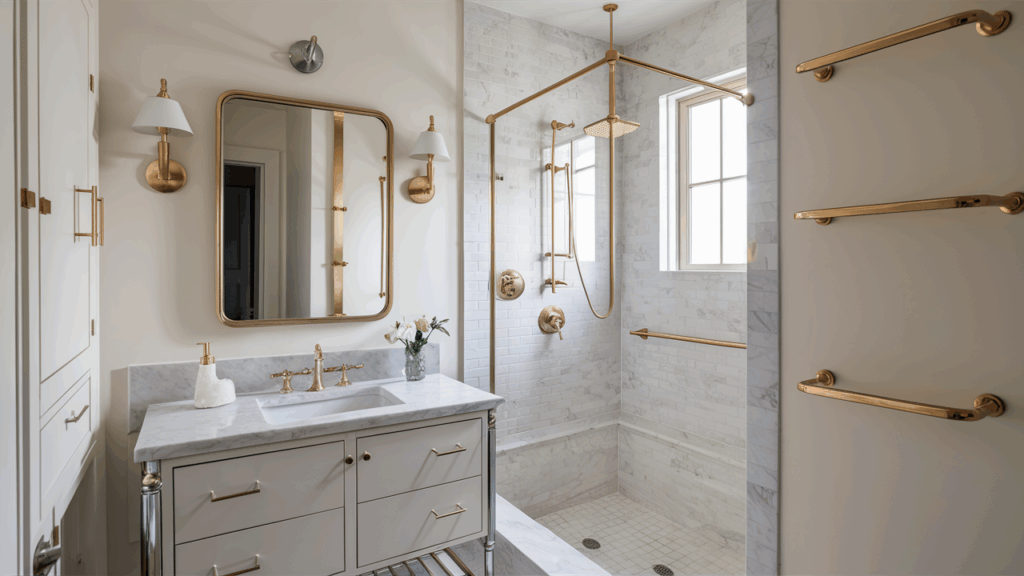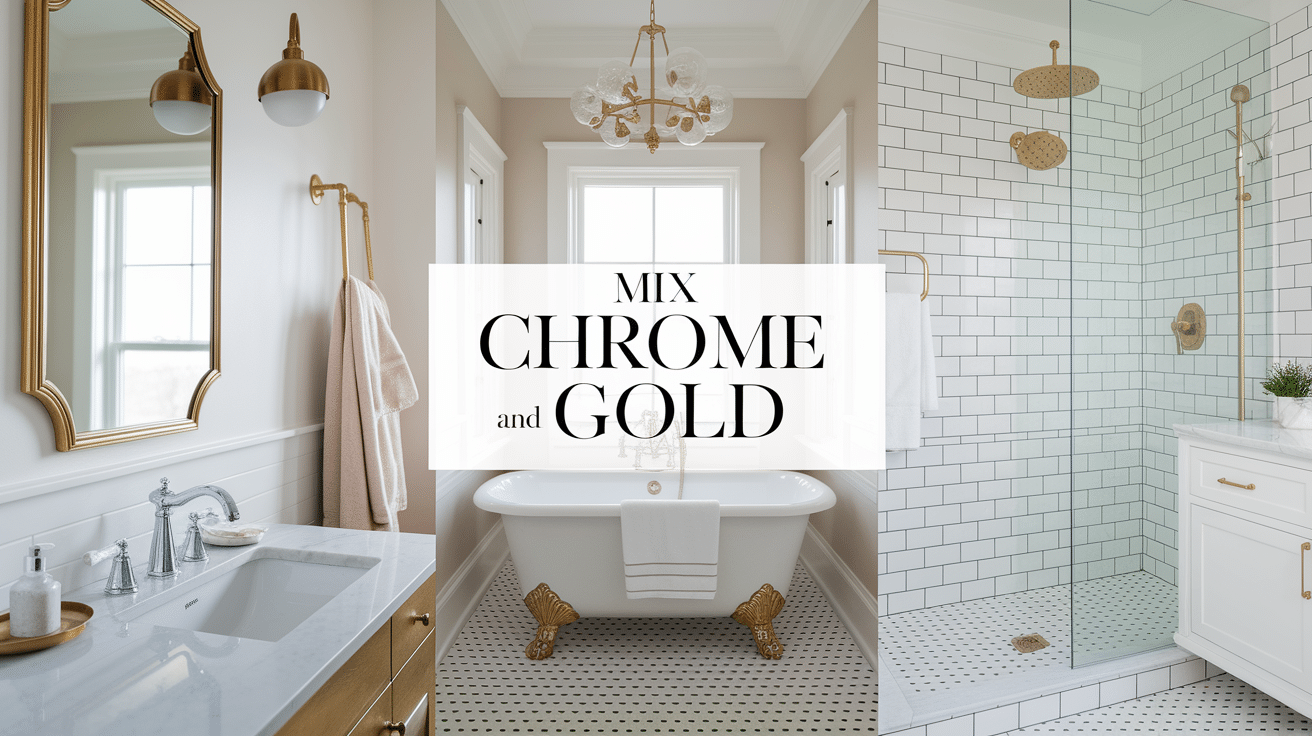Ever wondered how to make chrome and gold work together in your bathroom? You’re not alone. Many homeowners struggle with mixing these popular metals without creating a design mess.
In this article, I’ll show you exactly how to blend chrome fixtures with gold accents for a bathroom that looks intentionally designed, not thrown together.
You’ll learn:
- Which gold tones pair best with chrome
- Simple ways to balance these metals throughout your space
- Budget-friendly tips to update your bathroom this weekend
I’ve helped hundreds of homeowners solve this exact design dilemma. After reading, you’ll have a clear plan to create a bathroom that feels both modern and timeless.
No more guessing or costly mistakes. Just practical advice you can use right away to transform your bathroom into a space you’ll love showing off.
Why Mix Metals in the First Place?

I love mixing metals in my jewelry and home decor. You might wonder why.
Mixing metals adds visual interest. It creates depth. Think gold with silver or copper with bronze.
When everything matches perfectly, it can look flat. Too perfect. Too planned.
But why should you mix metals? Let me explain.
First, it gives you freedom. No more hunting for that exact brass doorknob to match your cabinet pulls!
It’s also timeless. Designer spaces have featured mixed metals for decades. It’s not just a passing trend.
Here’s why mixing metals works so well:
- It adds dimension to your space
- It creates a collected-over-time look
- It allows you to incorporate family heirlooms
- It gives you flexibility when shopping
The key is balance. Not chaos.
I find that mixing 2-3 metal finishes works best. Any more might feel cluttered.
What metals work well together? With the right approach, almost any combination can work: warm with cool, shiny with matte.
Try it yourself. Start small. Maybe mix your picture frames or kitchen hardware.
You’ll be surprised at how natural it looks.
Start with a Dominant Metal
I always tell people to pick a main metal first. It creates a foundation for your design.
Chrome or gold make excellent base choices. Your faucets and shower fixtures often define this primary metal.
Think of your second metal as the supporting character. It complements without competing.
Here’s a designer secret: Chrome creates a clean, modern base. It feels fresh and timeless in contemporary spaces.
Gold, on the other hand, highlights warmth and adds richness against a cooler backdrop.
Balance matters. Too many competing metals create visual chaos.
When I designed my bathroom, I chose chrome fixtures throughout. Then, I added gold-framed mirrors and cabinet pulls. The contrast works beautifully.
Your dominant metal should represent about 60-70% of the metal finishes in your space.
First, try this approach in your kitchen or bathroom. It’s the easiest place to control your metal mix and see immediate results.
Remember: start with one strong choice, then build from there.
Use Finishes That Complement Each Other
Matching Sheens
I always match sheen levels when mixing metals. Polished works with polished. Matte pairs with matte.
Think about how light bounces off surfaces. When your metals reflect light similarly, they create a cohesive look.
The finish matters as much as the metal itself.
Watch Your Metal Count
Too many metal styles create visual confusion, and Antique brass should not compete with ultra-modern chrome in the same space.
I learned this the hard way during my kitchen renovation. Three different metal finishes looked intentional, while five looked chaotic.
Keep it simple. Two to three metal finishes are plenty.
Choose Complementary Tones
Warm golds like brushed brass offer a softer contrast when paired with chrome. The brushed texture tones down the warmth, making it blend better with cooler metals.
I once mixed polished chrome faucets with a hammered copper sink. The result? Jarring.
When I switched to brushed brass fixtures instead, everything clicked into place.
Try this: Hold your metal samples side by side. If they feel like they belong to the same design era, you’re on the right track.
Spread Both Finishes Around the Room
Create Visual Balance
I always distribute metal finishes throughout the room. Don’t isolate gold to one corner. It creates an imbalance.
Think of your metals like dots on a map. They should appear in different areas, creating a sense of purpose.
When metals are scattered randomly, the eye travels naturally around the space.
Mix With Intention
Consider this bathroom example: chrome faucet + gold mirror + chrome towel bar + gold light fixture.
Do you see how the finishes alternate? This creates rhythm and flow.
Intentional placement makes mixed metals look designed, not accidental.
Repeat For Cohesion
Each metal finish should appear at least twice in your room. This repetition tells the brain it’s intentional.
I once designed a kitchen with brass pendants but nothing else brass. It looked like a mistake.
When I added brass cabinet pulls and a brass pot filler, suddenly, everything felt connected.
Try this approach in your own space: Stand in the doorway and notice if your metals create a balanced pattern across the room.
Remember that distribution matters as much as selection. Your metals should have a conversation across the space.
Conclusion
When done thoughtfully, mixing metals adds character and depth to your space. I’ve found that starting with a dominant metal creates a foundation, while complementary finishes ensure harmony.
Remember to match sheen levels and limit your metal count to avoid visual chaos. The key is distribution; spread your finishes throughout the room and repeat each one at least twice.
This creates balance and intention. When you follow these simple guidelines, your mixed metals will look curated rather than haphazard.
Trust your eye, but follow these principles, and you’ll create a timeless look that feels both designed and effortless. The perfect metal mix brings warmth, interest, and personality to your home in a way that matching everything cannot achieve.

